Qian Chen
Say More with Less: Variable-Frame-Rate Speech Tokenization via Adaptive Clustering and Implicit Duration Coding
Sep 04, 2025Abstract:Existing speech tokenizers typically assign a fixed number of tokens per second, regardless of the varying information density or temporal fluctuations in the speech signal. This uniform token allocation mismatches the intrinsic structure of speech, where information is distributed unevenly over time. To address this, we propose VARSTok, a VAriable-frame-Rate Speech Tokenizer that adapts token allocation based on local feature similarity. VARSTok introduces two key innovations: (1) a temporal-aware density peak clustering algorithm that adaptively segments speech into variable-length units, and (2) a novel implicit duration coding scheme that embeds both content and temporal span into a single token index, eliminating the need for auxiliary duration predictors. Extensive experiments show that VARSTok significantly outperforms strong fixed-rate baselines. Notably, it achieves superior reconstruction naturalness while using up to 23% fewer tokens than a 40 Hz fixed-frame-rate baseline. VARSTok further yields lower word error rates and improved naturalness in zero-shot text-to-speech synthesis. To the best of our knowledge, this is the first work to demonstrate that a fully dynamic, variable-frame-rate acoustic speech tokenizer can be seamlessly integrated into downstream speech language models. Speech samples are available at https://zhengrachel.github.io/VARSTok.
SpeakerLM: End-to-End Versatile Speaker Diarization and Recognition with Multimodal Large Language Models
Aug 08, 2025Abstract:The Speaker Diarization and Recognition (SDR) task aims to predict "who spoke when and what" within an audio clip, which is a crucial task in various real-world multi-speaker scenarios such as meeting transcription and dialogue systems. Existing SDR systems typically adopt a cascaded framework, combining multiple modules such as speaker diarization (SD) and automatic speech recognition (ASR). The cascaded systems suffer from several limitations, such as error propagation, difficulty in handling overlapping speech, and lack of joint optimization for exploring the synergy between SD and ASR tasks. To address these limitations, we introduce SpeakerLM, a unified multimodal large language model for SDR that jointly performs SD and ASR in an end-to-end manner. Moreover, to facilitate diverse real-world scenarios, we incorporate a flexible speaker registration mechanism into SpeakerLM, enabling SDR under different speaker registration settings. SpeakerLM is progressively developed with a multi-stage training strategy on large-scale real data. Extensive experiments show that SpeakerLM demonstrates strong data scaling capability and generalizability, outperforming state-of-the-art cascaded baselines on both in-domain and out-of-domain public SDR benchmarks. Furthermore, experimental results show that the proposed speaker registration mechanism effectively ensures robust SDR performance of SpeakerLM across diverse speaker registration conditions and varying numbers of registered speakers.
Cardiac-CLIP: A Vision-Language Foundation Model for 3D Cardiac CT Images
Jul 29, 2025



Abstract:Foundation models have demonstrated remarkable potential in medical domain. However, their application to complex cardiovascular diagnostics remains underexplored. In this paper, we present Cardiac-CLIP, a multi-modal foundation model designed for 3D cardiac CT images. Cardiac-CLIP is developed through a two-stage pre-training strategy. The first stage employs a 3D masked autoencoder (MAE) to perform self-supervised representation learning from large-scale unlabeled volumetric data, enabling the visual encoder to capture rich anatomical and contextual features. In the second stage, contrastive learning is introduced to align visual and textual representations, facilitating cross-modal understanding. To support the pre-training, we collect 16641 real clinical CT scans, supplemented by 114k publicly available data. Meanwhile, we standardize free-text radiology reports into unified templates and construct the pathology vectors according to diagnostic attributes, based on which the soft-label matrix is generated to supervise the contrastive learning process. On the other hand, to comprehensively evaluate the effectiveness of Cardiac-CLIP, we collect 6,722 real-clinical data from 12 independent institutions, along with the open-source data to construct the evaluation dataset. Specifically, Cardiac-CLIP is comprehensively evaluated across multiple tasks, including cardiovascular abnormality classification, information retrieval and clinical analysis. Experimental results demonstrate that Cardiac-CLIP achieves state-of-the-art performance across various downstream tasks in both internal and external data. Particularly, Cardiac-CLIP exhibits great effectiveness in supporting complex clinical tasks such as the prospective prediction of acute coronary syndrome, which is notoriously difficult in real-world scenarios.
SlimCaching: Edge Caching of Mixture-of-Experts for Distributed Inference
Jul 09, 2025Abstract:Mixture-of-Experts (MoE) models improve the scalability of large language models (LLMs) by activating only a small subset of relevant experts per input. However, the sheer number of expert networks in an MoE model introduces a significant storage burden for an edge device. To address this challenge, we consider a scenario where experts are dispersed within an edge network for distributed inference. Based on the popular Top-$K$ expert selection strategy, we formulate a latency minimization problem by optimizing expert caching on edge servers under storage constraints. When $K=1$, the problem reduces to a monotone submodular maximization problem with knapsack constraints, for which we design a greedy-based algorithm with a $(1 - 1/e)$-approximation guarantee. For the general case where $K\geq1$, expert co-activation within the same MoE layer introduces non-submodularity, causing greedy methods to be ineffective. To tackle this issue, we propose a successive greedy decomposition method to decompose the original problem into a series of subproblems, with each being solved by a dynamic programming approach. Furthermore, we design an accelerated algorithm based on the max-convolution technique to obtain the approximate solution with a provable guarantee in polynomial time. Simulation results on various MoE models demonstrate that our method significantly reduces inference latency compared to existing baselines.
KaLM-Embedding-V2: Superior Training Techniques and Data Inspire A Versatile Embedding Model
Jun 26, 2025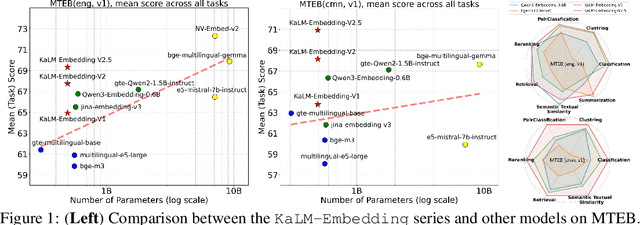



Abstract:In this paper, we propose KaLM-Embedding-V2, a versatile and compact embedding model, which achieves impressive performance in general-purpose text embedding tasks by leveraging superior training techniques and data. Our key innovations include: (1) To better align the architecture with representation learning, we remove the causal attention mask and adopt a fully bidirectional transformer with simple yet effective mean-pooling to produce fixed-length embeddings; (2) We employ a multi-stage training pipeline: (i) pre-training on large-scale weakly supervised open-source corpora; (ii) fine-tuning on high-quality retrieval and non-retrieval datasets; and (iii) model-soup parameter averaging for robust generalization. Besides, we introduce a focal-style reweighting mechanism that concentrates learning on difficult samples and an online hard-negative mixing strategy to continuously enrich hard negatives without expensive offline mining; (3) We collect over 20 categories of data for pre-training and 100 categories of data for fine-tuning, to boost both the performance and generalization of the embedding model. Extensive evaluations on the Massive Text Embedding Benchmark (MTEB) Chinese and English show that our model significantly outperforms others of comparable size, and competes with 3x, 14x, 18x, and 26x larger embedding models, setting a new standard for a versatile and compact embedding model with less than 1B parameters.
ThinkSound: Chain-of-Thought Reasoning in Multimodal Large Language Models for Audio Generation and Editing
Jun 26, 2025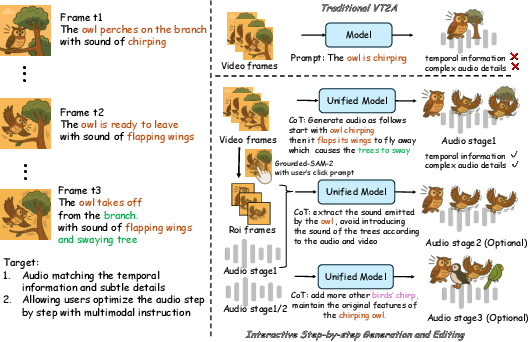

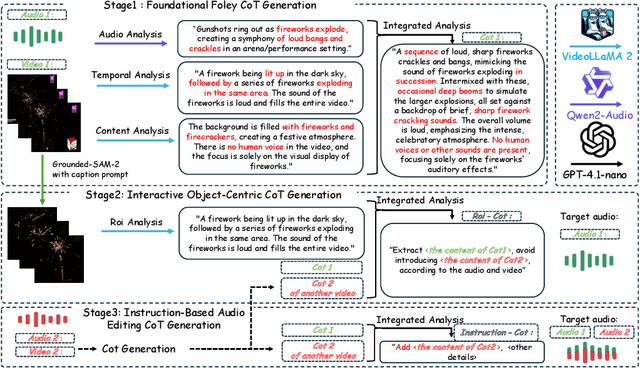
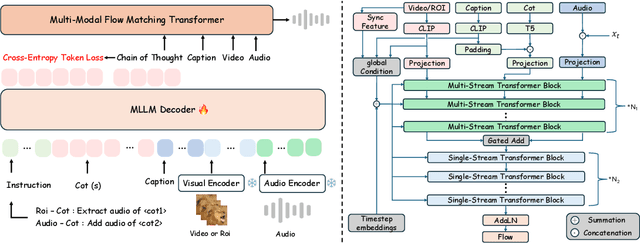
Abstract:While end-to-end video-to-audio generation has greatly improved, producing high-fidelity audio that authentically captures the nuances of visual content remains challenging. Like professionals in the creative industries, such generation requires sophisticated reasoning about items such as visual dynamics, acoustic environments, and temporal relationships. We present \textbf{ThinkSound}, a novel framework that leverages Chain-of-Thought (CoT) reasoning to enable stepwise, interactive audio generation and editing for videos. Our approach decomposes the process into three complementary stages: foundational foley generation that creates semantically coherent soundscapes, interactive object-centric refinement through precise user interactions, and targeted editing guided by natural language instructions. At each stage, a multimodal large language model generates contextually aligned CoT reasoning that guides a unified audio foundation model. Furthermore, we introduce \textbf{AudioCoT}, a comprehensive dataset with structured reasoning annotations that establishes connections between visual content, textual descriptions, and sound synthesis. Experiments demonstrate that ThinkSound achieves state-of-the-art performance in video-to-audio generation across both audio metrics and CoT metrics and excels in out-of-distribution Movie Gen Audio benchmark. The demo page is available at https://ThinkSound-Demo.github.io.
OmniDRCA: Parallel Speech-Text Foundation Model via Dual-Resolution Speech Representations and Contrastive Alignment
Jun 11, 2025Abstract:Recent studies on end-to-end speech generation with large language models (LLMs) have attracted significant community attention, with multiple works extending text-based LLMs to generate discrete speech tokens. Existing approaches primarily fall into two categories: (1) Methods that generate discrete speech tokens independently without incorporating them into the LLM's autoregressive process, resulting in text generation being unaware of concurrent speech synthesis. (2) Models that generate interleaved or parallel speech-text tokens through joint autoregressive modeling, enabling mutual modality awareness during generation. This paper presents OmniDRCA, a parallel speech-text foundation model based on joint autoregressive modeling, featuring dual-resolution speech representations and contrastive cross-modal alignment. Our approach processes speech and text representations in parallel while enhancing audio comprehension through contrastive alignment. Experimental results on Spoken Question Answering benchmarks demonstrate that OmniDRCA establishes new state-of-the-art (SOTA) performance among parallel joint speech-text modeling based foundation models, and achieves competitive performance compared to interleaved models. Additionally, we explore the potential of extending the framework to full-duplex conversational scenarios.
Speech Token Prediction via Compressed-to-fine Language Modeling for Speech Generation
May 30, 2025Abstract:Neural audio codecs, used as speech tokenizers, have demonstrated remarkable potential in the field of speech generation. However, to ensure high-fidelity audio reconstruction, neural audio codecs typically encode audio into long sequences of speech tokens, posing a significant challenge for downstream language models in long-context modeling. We observe that speech token sequences exhibit short-range dependency: due to the monotonic alignment between text and speech in text-to-speech (TTS) tasks, the prediction of the current token primarily relies on its local context, while long-range tokens contribute less to the current token prediction and often contain redundant information. Inspired by this observation, we propose a \textbf{compressed-to-fine language modeling} approach to address the challenge of long sequence speech tokens within neural codec language models: (1) \textbf{Fine-grained Initial and Short-range Information}: Our approach retains the prompt and local tokens during prediction to ensure text alignment and the integrity of paralinguistic information; (2) \textbf{Compressed Long-range Context}: Our approach compresses long-range token spans into compact representations to reduce redundant information while preserving essential semantics. Extensive experiments on various neural audio codecs and downstream language models validate the effectiveness and generalizability of the proposed approach, highlighting the importance of token compression in improving speech generation within neural codec language models. The demo of audio samples will be available at https://anonymous.4open.science/r/SpeechTokenPredictionViaCompressedToFinedLM.
CosyVoice 3: Towards In-the-wild Speech Generation via Scaling-up and Post-training
May 23, 2025Abstract:In our prior works, we introduced a scalable streaming speech synthesis model, CosyVoice 2, which integrates a large language model (LLM) and a chunk-aware flow matching (FM) model, and achieves low-latency bi-streaming speech synthesis and human-parity quality. Despite these advancements, CosyVoice 2 exhibits limitations in language coverage, domain diversity, data volume, text formats, and post-training techniques. In this paper, we present CosyVoice 3, an improved model designed for zero-shot multilingual speech synthesis in the wild, surpassing its predecessor in content consistency, speaker similarity, and prosody naturalness. Key features of CosyVoice 3 include: 1) A novel speech tokenizer to improve prosody naturalness, developed via supervised multi-task training, including automatic speech recognition, speech emotion recognition, language identification, audio event detection, and speaker analysis. 2) A new differentiable reward model for post-training applicable not only to CosyVoice 3 but also to other LLM-based speech synthesis models. 3) Dataset Size Scaling: Training data is expanded from ten thousand hours to one million hours, encompassing 9 languages and 18 Chinese dialects across various domains and text formats. 4) Model Size Scaling: Model parameters are increased from 0.5 billion to 1.5 billion, resulting in enhanced performance on our multilingual benchmark due to the larger model capacity. These advancements contribute significantly to the progress of speech synthesis in the wild. We encourage readers to listen to the demo at https://funaudiollm.github.io/cosyvoice3.
Pushing the Frontiers of Self-Distillation Prototypes Network with Dimension Regularization and Score Normalization
May 20, 2025

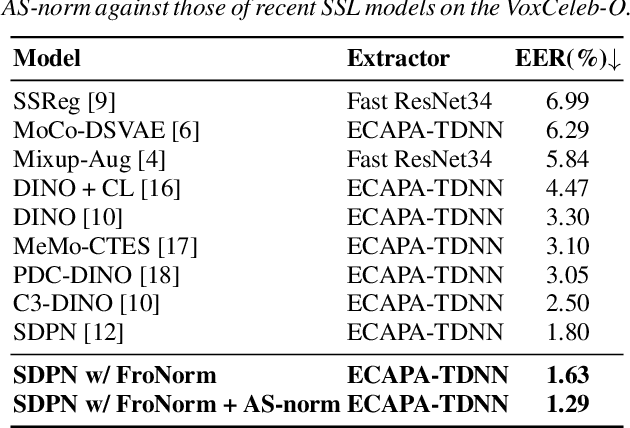
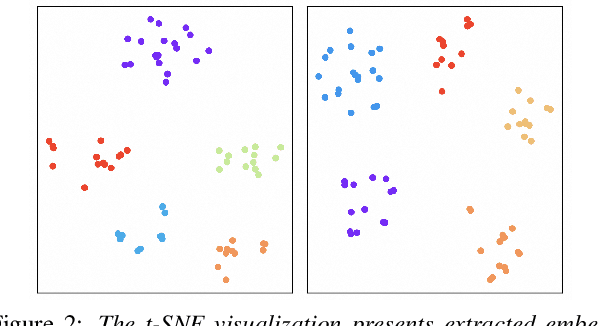
Abstract:Developing robust speaker verification (SV) systems without speaker labels has been a longstanding challenge. Earlier research has highlighted a considerable performance gap between self-supervised and fully supervised approaches. In this paper, we enhance the non-contrastive self-supervised framework, Self-Distillation Prototypes Network (SDPN), by introducing dimension regularization that explicitly addresses the collapse problem through the application of regularization terms to speaker embeddings. Moreover, we integrate score normalization techniques from fully supervised SV to further bridge the gap toward supervised verification performance. SDPN with dimension regularization and score normalization sets a new state-of-the-art on the VoxCeleb1 speaker verification evaluation benchmark, achieving Equal Error Rate 1.29%, 1.60%, and 2.80% for trial VoxCeleb1-{O,E,H} respectively. These results demonstrate relative improvements of 28.3%, 19.6%, and 22.6% over the current best self-supervised methods, thereby advancing the frontiers of SV technology.
 Add to Chrome
Add to Chrome Add to Firefox
Add to Firefox Add to Edge
Add to Edge